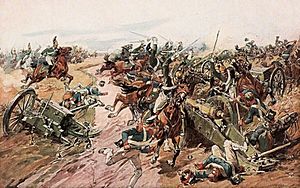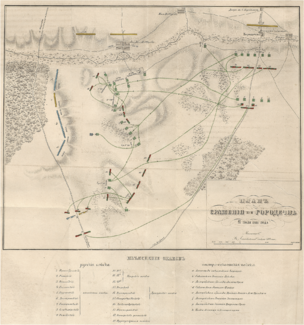Battle of Gorodechno facts for kids
Quick facts for kids Battle of Gorodechno |
|||||||
|---|---|---|---|---|---|---|---|
| Part of the French invasion of Russia | |||||||
 Attack of a Dragoon regiment on the French artillery (painting by Nikolay Samokish) |
|||||||
|
|||||||
| Belligerents | |||||||
| Commanders and leaders | |||||||
| Strength | |||||||
| 18,000 | 40,000 | ||||||
| Casualties and losses | |||||||
| 3,000 | 1,300 Austrians 930 Saxons |
||||||
The Battle of Gorodechno was an important fight during the French invasion of Russia in 1812. It happened on August 12, 1812, near a town called Gorodechno. This battle was between the armies of Napoleon's allies, Austria and Saxony, and the Russian army. The Austrian and Saxon forces were led by Prince Schwarzenberg. The Russian troops were commanded by Alexander Tormasov. In the end, Napoleon's allies won, and the Russian army had to retreat.
Contents
Why the Battle Happened
In July 1812, Napoleon's huge army, called the Grande Armée, was marching into Russia. Napoleon wanted to conquer Russia. His main army was heading towards Moscow.
On the right side of Napoleon's main army, his allies, Austria and Saxony, were also moving into Russia. These allied forces had about 30,000 Austrian soldiers led by Prince Schwarzenberg. They also had 13,000 Saxon soldiers led by General Jean Reynier.
Meanwhile, the Russian army, led by General Alexander Tormasov, was trying to stop them. Tormasov had about 40,000 soldiers. His job was to get behind Napoleon's forces. He aimed to cause trouble and cut off their supplies and messages.
In July, the Russians had a victory at Kobryn. They also sent troops to other towns, causing panic. Because Napoleon's allies were chasing him, Tormasov decided to pull back. He took a strong defensive spot at Gorodechno, waiting for the battle.
The Battle Begins
The battle started early in the morning on August 12, 1812. The Austrian and Saxon allies attacked. They used special paths, called causeways, to cross a marshy area. General Tormasov had set up his defense line and cannons behind this marsh.
General Reynier and the Saxon cavalry had good success at first. They managed to cross the northern causeway without much trouble. This allowed them to start moving around the left side of the Russian army. Tormasov quickly moved his soldiers to form a new defense line on his left side.
Fighting Through the Day
The battle continued all day long. Both sides fired their cannons a lot. Tormasov and the Russian defenses on the left side held strong. They stopped the allies from completely surrounding their position.
At the same time, the Saxon forces also attacked the center of the Russian line. They had cannon support. The Russians kept holding their ground firmly. The allies' first attempt to break through the center failed.
Later in the evening, some Austrian soldiers joined the fight in the center. They had struggled to walk through the marshes to get there. There was a tough fight for the higher ground. The allies managed to gain a position, but the Russians pushed them back later. The fighting on the Russian left side also continued, but the allies couldn't break through there either. By the end of the day, thousands of soldiers on both sides were dead or wounded.
Russian Retreat
Even though the Russian defense line was still in place, General Tormasov made a big decision that evening. He decided to pull his troops back. He believed the allies would attack again the next morning. He thought they would use 21 fresh groups of soldiers who hadn't fought yet. So, the Russian army retreated, and Napoleon's allies won the battle.
See also


